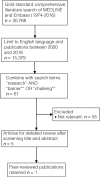Trends, Challenges, and Opportunities Regarding Research in Non-traumatic Spinal Cord Dysfunction
- PMID: 29339907
- PMCID: PMC5667428
- DOI: 10.1310/sci2304-313
Trends, Challenges, and Opportunities Regarding Research in Non-traumatic Spinal Cord Dysfunction
Abstract
Background: Spinal cord dysfunction (SCDys) is caused by heterogeneous health conditions, and the incidence is increasing. Despite the growing interest in rehabilitation research for SCDys, research into SCDys faces many challenges. Objective: The objective of this project was to perform a clinical review of changes in SCDys research over the last 4 decades; identify challenges to conducting research in SCDys; and propose opportunities for improving research in SCDys. Methods: A triangulation approach was used for obtaining evidence: literature search (January 2017) using MEDLINE and Embase databases for publications in English (1974-2016) regarding SCDys; workshop discussions at the International Spinal Cord Society annual meeting, September 16, 2016, Vienna, Austria; and our collective expertise in SCDys clinical rehabilitation research. Results: There has been a substantial increase in publications on SCDys over the 4 decades, from 1,825 in 1974-1983 to 11,887 in the decade 2004-2013, along with an improvement in research methodology. Numerous challenges to research in SCDys rehabilitation were grouped into the following themes: (a) identification of cases; (b) study design and data collection; and (c) funding, preclinical, and international research. Opportunities for addressing these were identified. Conclusions: The increase in scientific publications on SCDys highlights the importance of this heterogeneous group among the research community. The overall lack of good quality epidemiological studies regarding incidence, prevalence, and survival in these patients serves as a benchmark for guiding improvements to inform evidence-based care and policy.
Keywords: epidemiology; health services; rehabilitation; research; spinal cord diseases; spinal cord dysfunction; spinal cord injury.
Figures
Similar articles
-
Important Clinical Rehabilitation Principles Unique to People with Non-traumatic Spinal Cord Dysfunction.Top Spinal Cord Inj Rehabil. 2017 Fall;23(4):299-312. doi: 10.1310/sci2304-299. Top Spinal Cord Inj Rehabil. 2017. PMID: 29339906 Free PMC article. Review.
-
Rehabilitation of people with spinal cord damage due to tumor: literature review, international survey and practical recommendations for optimizing their rehabilitation.J Spinal Cord Med. 2017 Mar;40(2):213-221. doi: 10.1080/10790268.2016.1173321. Epub 2016 Apr 18. J Spinal Cord Med. 2017. PMID: 27088581 Free PMC article. Review.
-
A Narrative Review of Pediatric Nontraumatic Spinal Cord Dysfunction.Top Spinal Cord Inj Rehabil. 2019 Spring;25(2):112-120. doi: 10.1310/sci2502-112. Top Spinal Cord Inj Rehabil. 2019. PMID: 31068743 Free PMC article. Review.
-
Review of the History of Non-traumatic Spinal Cord Dysfunction.Top Spinal Cord Inj Rehabil. 2017 Fall;23(4):285-298. doi: 10.1310/sci2304-285. Top Spinal Cord Inj Rehabil. 2017. PMID: 29339905 Free PMC article. Review.
-
Recommendations for spinal rehabilitation professionals regarding sexual education needs and preferences of people with spinal cord dysfunction: a mixed-methods study.Spinal Cord. 2016 Dec;54(12):1203-1209. doi: 10.1038/sc.2016.62. Epub 2016 May 10. Spinal Cord. 2016. PMID: 27163451
Cited by
-
Survival after non-traumatic spinal cord injury: evidence from a population-based rehabilitation cohort in Switzerland.Spinal Cord. 2019 Apr;57(4):267-275. doi: 10.1038/s41393-018-0212-x. Epub 2018 Nov 9. Spinal Cord. 2019. PMID: 30413804
-
Nontraumatic Spinal Cord Injury: Epidemiology, Etiology and Management.J Pers Med. 2022 Nov 8;12(11):1872. doi: 10.3390/jpm12111872. J Pers Med. 2022. PMID: 36579590 Free PMC article.
-
Epidemiology of Traumatic and Non-Traumatic Spinal Cord Injury in Korea: A Narrative Review.Korean J Neurotrauma. 2023 Nov 9;19(4):434-445. doi: 10.13004/kjnt.2023.19.e54. eCollection 2023 Dec. Korean J Neurotrauma. 2023. PMID: 38222829 Free PMC article. Review.
-
The Swiss Spinal Cord Injury Cohort Study (SwiSCI) biobank: from concept to reality.Spinal Cord. 2024 Mar;62(3):117-124. doi: 10.1038/s41393-024-00958-x. Epub 2024 Jan 29. Spinal Cord. 2024. PMID: 38287141 Free PMC article.
-
Animal models of compression spinal cord injury.J Neurosci Res. 2022 Dec;100(12):2201-2212. doi: 10.1002/jnr.25120. Epub 2022 Sep 19. J Neurosci Res. 2022. PMID: 36121155 Free PMC article. Review.
References
-
- New PW, Sundararajan V.. Incidence of non-traumatic spinal cord injury in Victoria, Australia: A population-based study and literature review. Spinal Cord. 2008; 46: 406– 411. - PubMed
-
- Noonan VK, Fingas M, Farry A, . et al. The incidence and prevalence of SCI in Canada: A national perspective. Neuroepidemiology. 2012; 38: 219– 226. - PubMed
-
- New PW, Cripps RA, Lee BB.. A global map for non-traumatic spinal cord injury epidemiology: Towards a living data repository. Spinal Cord. 2014; 52: 97– 109. - PubMed
-
- New PW, Marshall R.. International spinal cord injury data sets for non-traumatic spinal cord injury. Spinal Cord. 2014; 52: 123– 132. - PubMed
-
- New PW, Reeves RK, Smith É, . et al. International retrospective comparison of inpatient rehabilitation for patients with spinal cord dysfunction epidemiology and clinical outcomes. Arch Phys Med Rehabil. 2015; 96: 1080– 1087. - PubMed
Publication types
MeSH terms
LinkOut - more resources
Full Text Sources
Other Literature Sources
Medical


